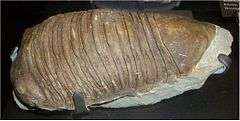Homalonotus
| Homalonotus | |
|---|---|
 | |
| Homalonotus sp. | |
| Scientific classification | |
| Kingdom: | Animalia |
| Phylum: | Arthropoda |
| Class: | Trilobita |
| Order: | Phacopida |
| Suborder: | Calymenina |
| Family: | Homalonotidae |
| Genus: | Homalonotus König, 1825, non Homalonotus Agassiz, 1846 = Homalinotus Schoenherr 1826, a beetle of uncertain affiliation[1] |
| Species | |
| |
Homalonotus is an extinct genus of trilobites in the order Phacopida. It contains several species, including H. armatus and H. roemeri.
Distribution
Fossils of Homalonotus have been found in:[2]
- Ordovician
France, and the United Kingdom
- Silurian
Canada (Nova Scotia), Poland, the United Kingdom, and the United States (New York)
- Devonian
Algeria, Bolivia, Brazil, Colombia (Floresta Formation, Altiplano Cundiboyacense), France, Morocco, New Zealand, Poland, and Ukraine
References
- ↑ Christopher Taylor. "Coleoptera". Variety of Life. Retrieved 2012-03-23.
- ↑ Homalonotus at Fossilworks.org
Further reading
- Cooper, Michael R. A Revision of the Devonian Trilobita from the Bokkeveld Group of South Africa. Cape Town: South African Museum, 1982.
- Salter, John William; Sedgwick, Adam; and Morris, John. A Catalogue of the Collection of Cambrian and Silurian Fossils Contained in the Geolological Museum of the University of Cambridge. Cambridge: University Press, 2010.
External links
| Wikimedia Commons has media related to Homalonotus. |
This article is issued from
Wikipedia.
The text is licensed under Creative Commons - Attribution - Sharealike.
Additional terms may apply for the media files.